Grinding Force and Surface Formation Mechanisms of 17CrNi2MoVNb Alloy When Grinding with CBN and Alumina Wheels
Abstract
:1. Introduction
2. Experimental Works
2.1. Materials
2.2. Experimental Setup
3. Results and Discussion
3.1. Grinding Force Analysis
3.2. Microstructure Evolution within Ground Surface Layer
3.3. Surface Roughness Analysis
4. Conclusions
- The normal force and tangential force generated by the CBN grinding wheel were up to ~64% and ~61% lower compared to the one from the alumina wheel due to the relatively higher wear resistance and thermal conductivity of the CBN wheel. The grinding force increased by about 20% when the grinding depth increased from 0.02 to 0.03 mm for CBN grinding wheels.
- Surface defects, including cavities and material tearing, were found on the ground surface when using an alumina grinding wheel. The cavities were mainly caused by the embedding of broken abrasive grains, and material tearing resulted from plastic deformation of materials under high temperature, which was adhered to the gaps of the grinding wheel and pulled out eventually.
- The influence of grinding wheel material on ground surface roughness was significant when compared with the effects of grinding parameters. The surface roughness Ra recorded from the CBN grinding wheel mainly ranged from 0.263 to 0.410 μm, accounting for less than 40% of the one from the alumina grinding wheel. CBN wheel presented a superior performance in grinding force and surface roughness with a feed speed of 0.19 m/s and grinding depth of 0.02 mm.
- The future direction is suggested to evaluate the effects of abrasive size on ground surface quality, corresponding wheel wear, and material removal mechanisms. The influence of surface integrity on fatigue performance is also important for further work.
Author Contributions
Funding
Institutional Review Board Statement
Informed Consent Statement
Data Availability Statement
Conflicts of Interest
References
- Yao, C.F.; Wang, T.; Xiao, W.; Huang, X.C.; Ren, J.X. Experimental study on grinding force and grinding temperature of Aermet 100 steel in surface grinding. J. Mater. Process. Technol. 2014, 214, 2191–2199. [Google Scholar] [CrossRef]
- Guerrini, G.; Lerra, F.; Fortunato, A. The effect of radial infeed on surface integrity in dry generating gear grinding for industrial production of automotive transmission gears. J. Manuf. Process. 2019, 45, 234–241. [Google Scholar] [CrossRef]
- Bhaduri, D.; Soo, S.L.; Aspinwall, D.K.; Novovic, D.; Harden, P.; Bohr, S.; Martin, D. A Study on ultrasonic assisted creep feed grinding of nickel based superalloys. Procedia CIRP 2012, 1, 359–364. [Google Scholar] [CrossRef] [Green Version]
- Gong, P.; Wang, D.L.; Zhang, C.; Wang, Y.; Jamili-Shirvan, Z.; Yao, K.F.; Wang, X.Y. Corrosion behavior of TiZrHfBeCu(Ni) high-entropy bulk metallic glasses in 3.5 wt.% NaCl. NPJ Mater. Degrad. 2022, 6, 77. [Google Scholar] [CrossRef]
- Jamshidi, H.; Budak, E. A 3D analytical thermal model in grinding considering a periodic heat source under dry and wet conditions. J. Mater. Process. Technol. 2021, 295, 117158. [Google Scholar] [CrossRef]
- Zhang, W.L.; Liu, C.B.; Yuan, Y.J.; Zhang, P.F.; Fan, X.Q.; Zhu, M.H. Probing the effect of abrasive wear on the grinding performance of rail grinding stones. J. Manuf. Process. 2021, 64, 493–507. [Google Scholar] [CrossRef]
- Zhang, W.L.; Zhang, P.F.; Zhang, J.; Fan, X.Q.; Zhu, M.H. Probing the effect of abrasive grit size on rail grinding behaviors. J. Manuf. Process. 2020, 53, 388–395. [Google Scholar] [CrossRef]
- Wang, R.X.; Zhou, K.; Yang, J.Y.; Ding, H.H.; Wang, W.J.; Guo, J.; Liu, Q.Y. Effects of abrasive material and hardness of grinding wheel on rail grinding behaviors. Wear 2020, 454–455, 203332. [Google Scholar] [CrossRef]
- Li, M.; Yin, J.F.; Che, L.B.; Ding, W.F.; Xu, J.H. Influence of alumina abrasive tool wear on ground surface characteristics and corrosion properties of K444 nickel-based superalloy. Chin. J. Aeronaut. 2022, 35, 339–351. [Google Scholar] [CrossRef]
- Dang, J.Q.; Zhang, H.; An, Q.L.; Ming, W.W.; Chen, M. Feasibility study of creep feed grinding of 300M steel with zirconium corundum wheel. Chin. J. Aeronaut. 2022, 35, 565–578. [Google Scholar] [CrossRef]
- Klocke, F.; Soo, S.L.; Karpuschewski, B.; Webster, J.A.; Novovic, D.; Elfizy, A.; Axinte, D.A.; Tönissen, S. Abrasive machining of advanced aerospace alloys and composites. CIRP Ann. 2015, 64, 581–604. [Google Scholar] [CrossRef]
- Denkena, B.; Preising, D.; Woiwode, S. Gear profile grinding with metal bonded CBN tools. Prod. Eng. Res. Dev. 2015, 9, 73–77. [Google Scholar] [CrossRef]
- Bhaduri, D.; Kumar, R.; Chattopadhyay, A.K. On the grindability of low-carbon steel under dry, cryogenic and neat oil environments with monolayer brazed cBN and alumina wheels. Int. J. Adv. Manuf. Technol. 2011, 57, 927–943. [Google Scholar] [CrossRef]
- Sato, B.K.; Lopes, J.C.; Rodriguez, R.L.; Garcia, M.V.; Mia, M.; Ribeiro, F.S.F.; Sanchez, L.E.D.A.; Aguiar, P.R.; Bianchi, E.C. Novel comparison concept between CBN and Al2O3 grinding process for eco-friendly production. J. Clean. Prod. 2022, 330, 129673. [Google Scholar] [CrossRef]
- Zhao, B.; Ding, W.F.; Xiao, G.D.; Zhao, J.S.; Li, Z. Self-sharpening property of porous metal-bonded aggregated cBN wheels during the grinding of Ti–6Al–4V alloys. Ceram. Int. 2022, 48, 1715–1722. [Google Scholar] [CrossRef]
- Zhang, G.Q.; He, X.F.; Zhang, Q.Z.; Wang, W.J.; Wang, M.Q. Comparison of microstructure and heat treatment distortion of gear steels with and without Nb addition. J. Iron. Steel. Res. Int. 2021, 28, 488–495. [Google Scholar] [CrossRef]
- Zhang, Y.L.; Qu, S.G.; Lai, F.Q.; Qin, H.D.; Huang, L.M.; Li, X.Q. Effect of quenching temperature on microstructure and rolling contact fatigue behavior of 17Cr2Ni2MoVNb steel. Metals 2018, 8, 735. [Google Scholar] [CrossRef] [Green Version]
- Qu, S.G.; Zhang, Y.L.; Lai, F.Q.; Li, X.Q. Effect of tempering temperatures on tensile properties and rotary bending fatigue behaviors of 17Cr2Ni2MoVNb steel. Metals 2018, 8, 507. [Google Scholar] [CrossRef] [Green Version]
- Ruzzi, R.S.; Silva, R.B.; Silva, L.R.R.; Machado, A.R.; Jackson, M.J.; Hassui, A. Influence of grinding parameters on Inconel 625 surface grinding. J. Manuf. Process. 2020, 55, 174–185. [Google Scholar] [CrossRef]
- Patidar, A.; Mandal, A.K.; Chaudhary, A.K. High speed super abrasive grinding of sintered yttria stabilised zirconia (YSZ) using single layer electroplated diamond grinding wheels. Mater. Today Proc. 2021, 45, 4660–4665. [Google Scholar] [CrossRef]
- Liu, Q.; Chen, X.; Gindy, N. Assessment of Al2O3 and superabrasive wheels in nickel-based alloy grinding. Int. J. Adv. Manuf. Technol. 2007, 33, 940–951. [Google Scholar] [CrossRef]
- Yang, M.H.; Chen, J.W.; Wu, C.S.; Xie, G.Z.; Jiang, X.Y.; Li, M.J.; He, H. Residual stress evolution and surface morphology in grinding of hardened steel following carburizing and quenching processes. Mater. Sci. Eng. Technol. 2022, 53, 1421–1436. [Google Scholar] [CrossRef]
- Jiang, X.Y.; Liu, K.; Yan, Y.; Li, M.J.; Gong, P.; He, H. Grinding temperature and surface integrity of quenched automotive transmission gear during the form grinding process. Materials 2022, 15, 7723. [Google Scholar] [CrossRef] [PubMed]
- Zhou, K.; Ding, H.H.; Wang, W.J.; Guo, J.; Liu, Q.Y. Surface integrity during rail grinding under wet conditions: Full-scale experiment and multi-grain grinding simulation. Tribol. Int. 2022, 165, 107327. [Google Scholar] [CrossRef]
- Zhang, X.D.; Jiang, X.Y.; Li, M.J.; Gong, P. Surface morphology and subsurface microstructure evolution when form grinding 20Cr2Ni4A alloys. Materials 2023, 16, 425. [Google Scholar] [CrossRef]
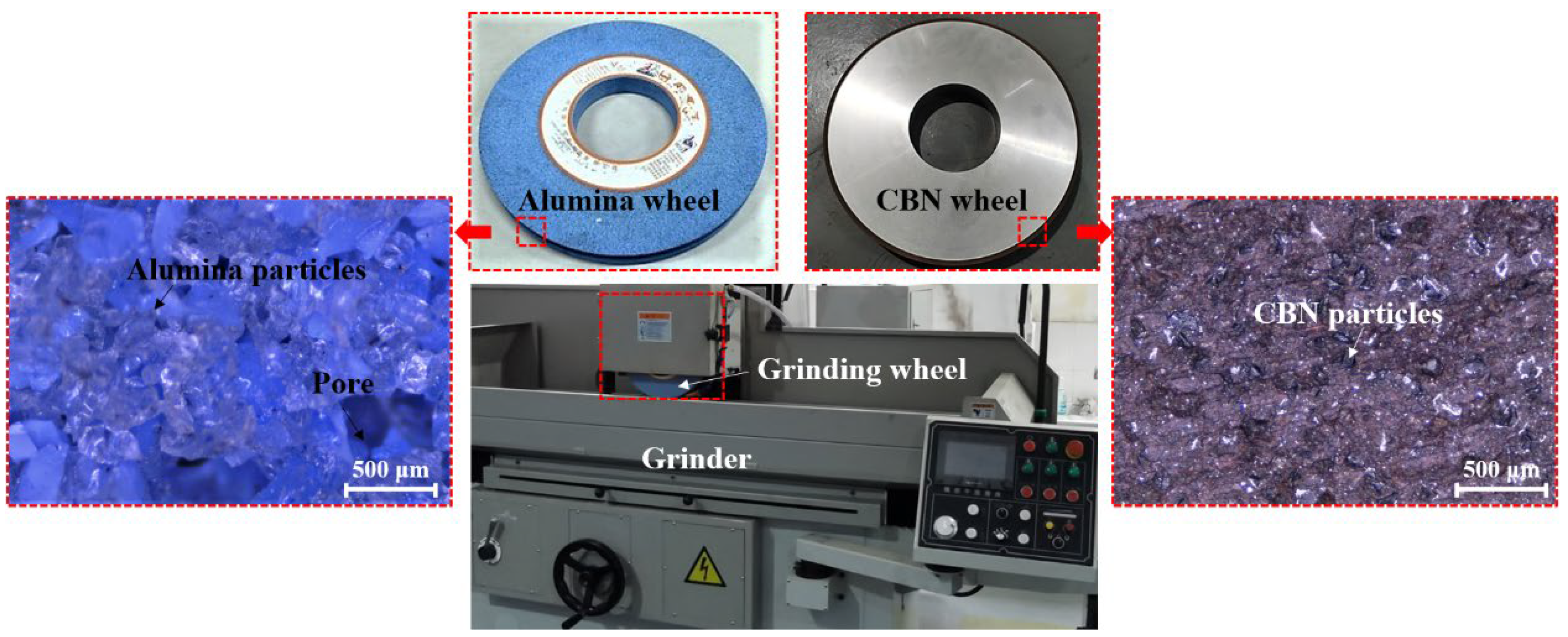
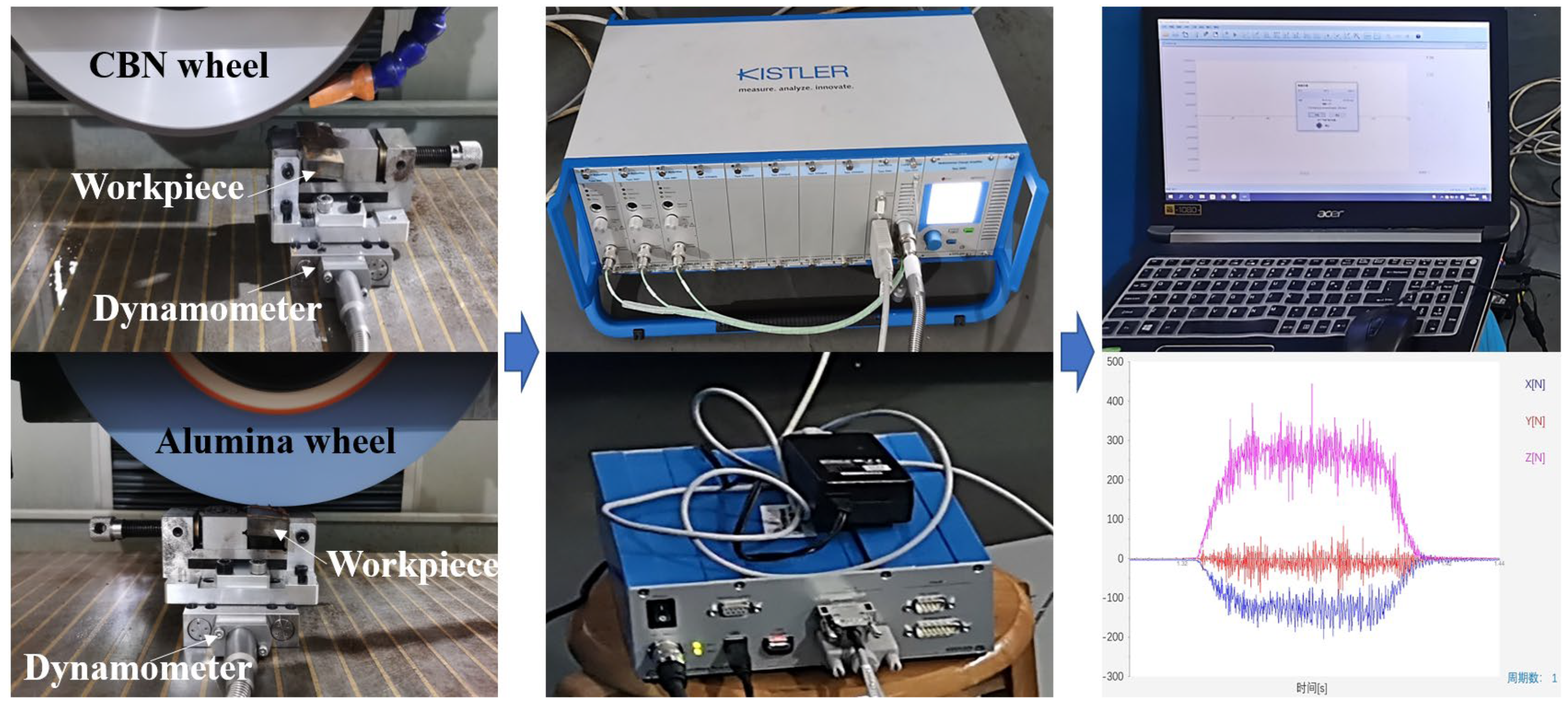
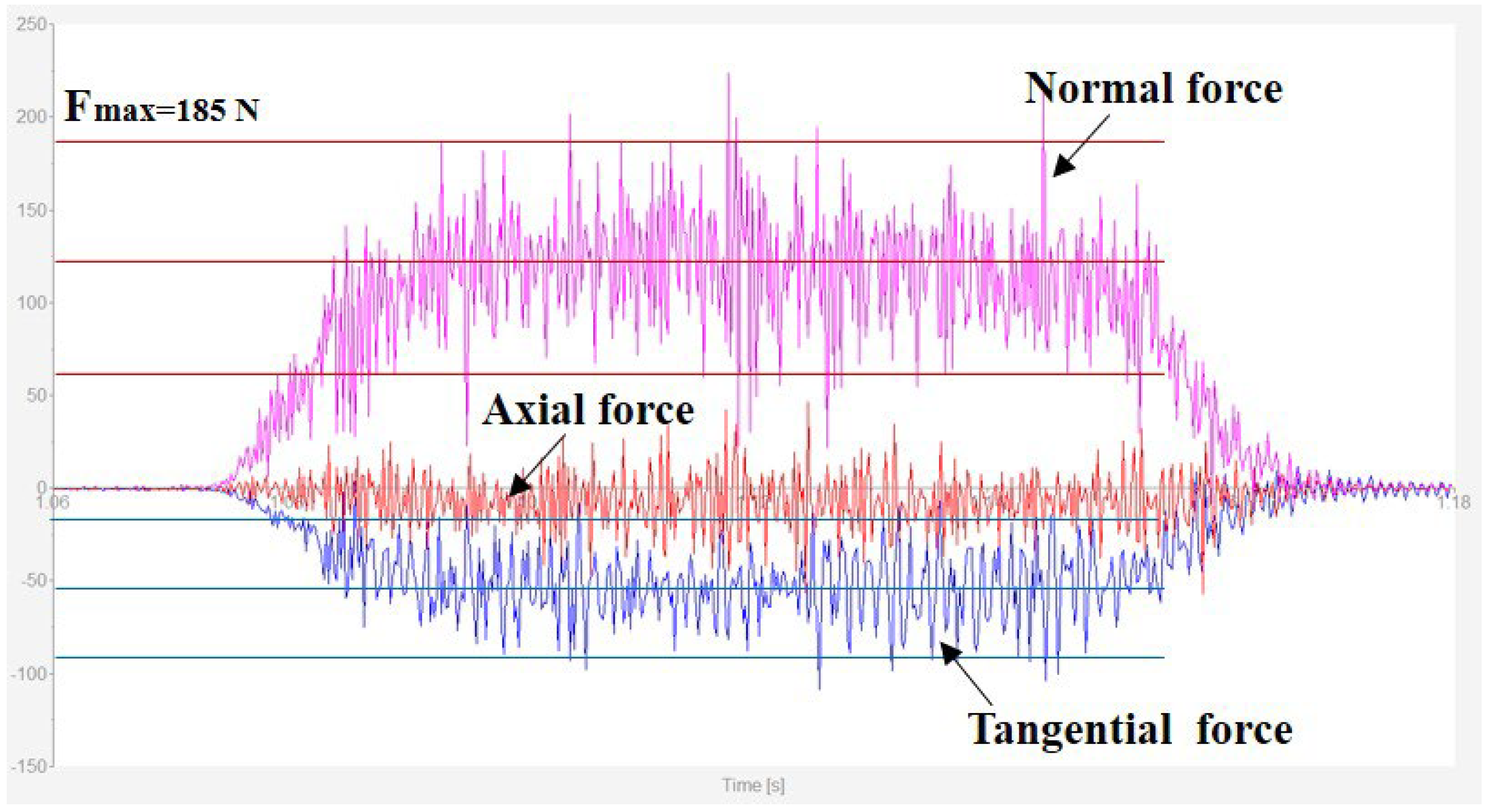
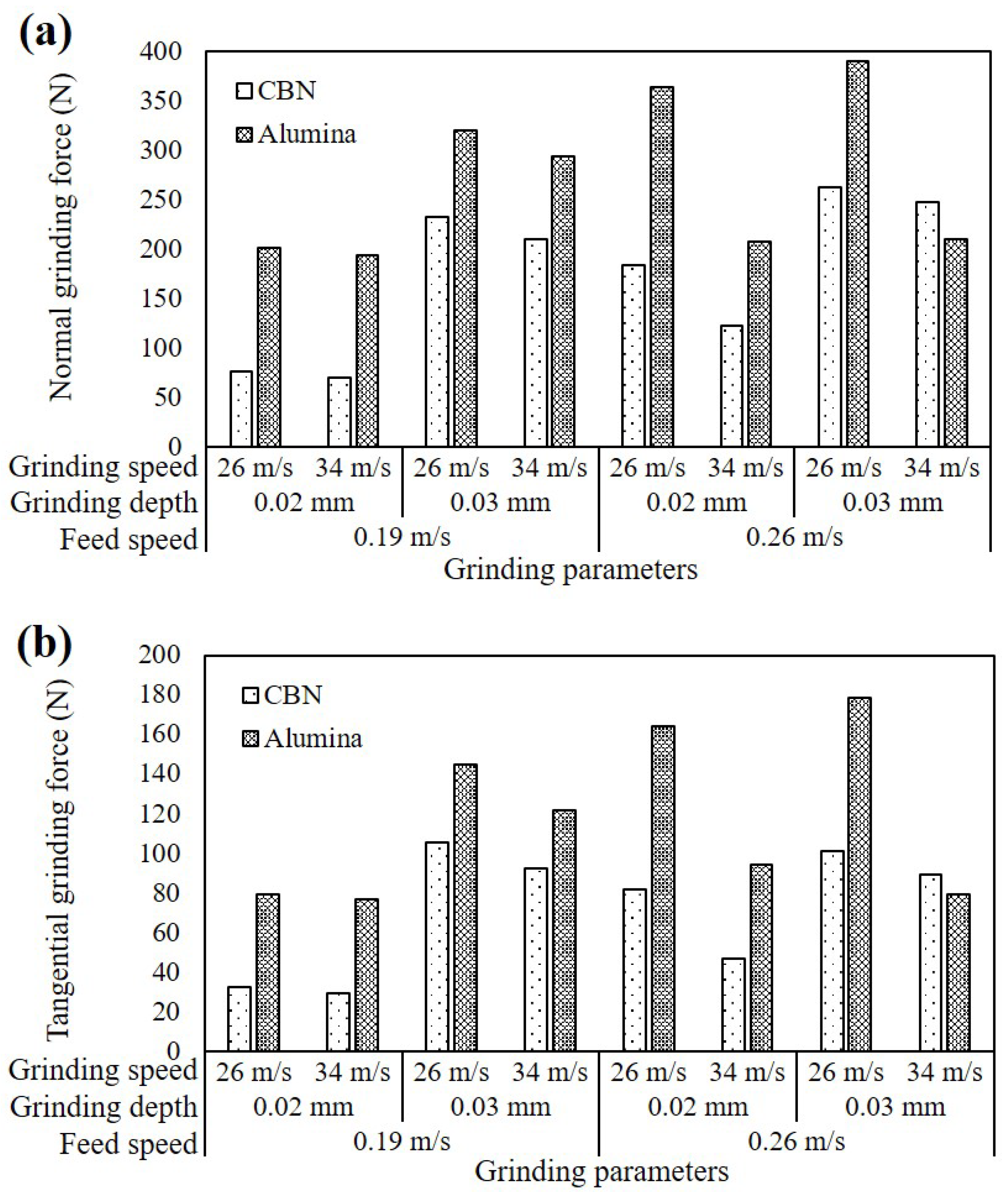
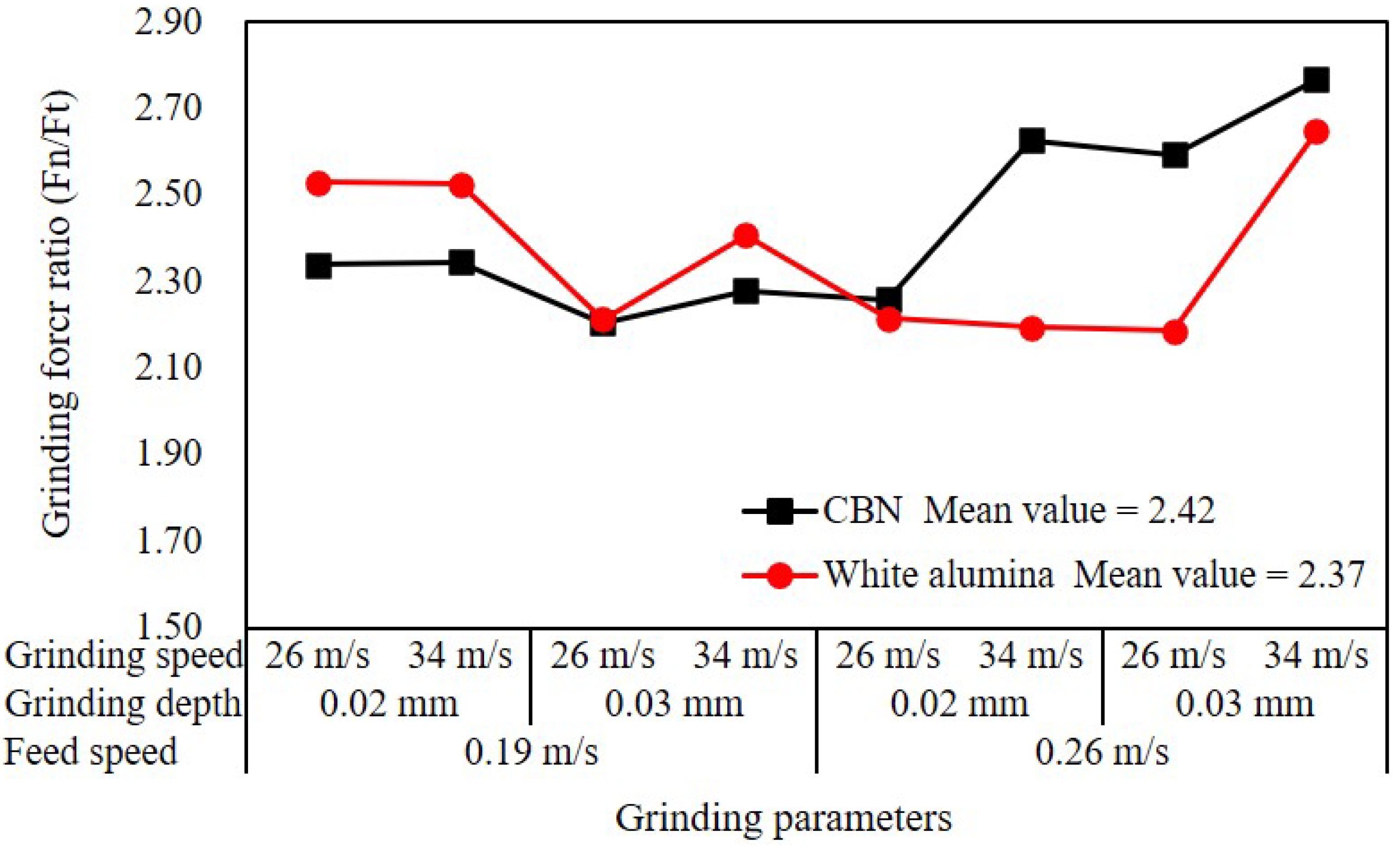

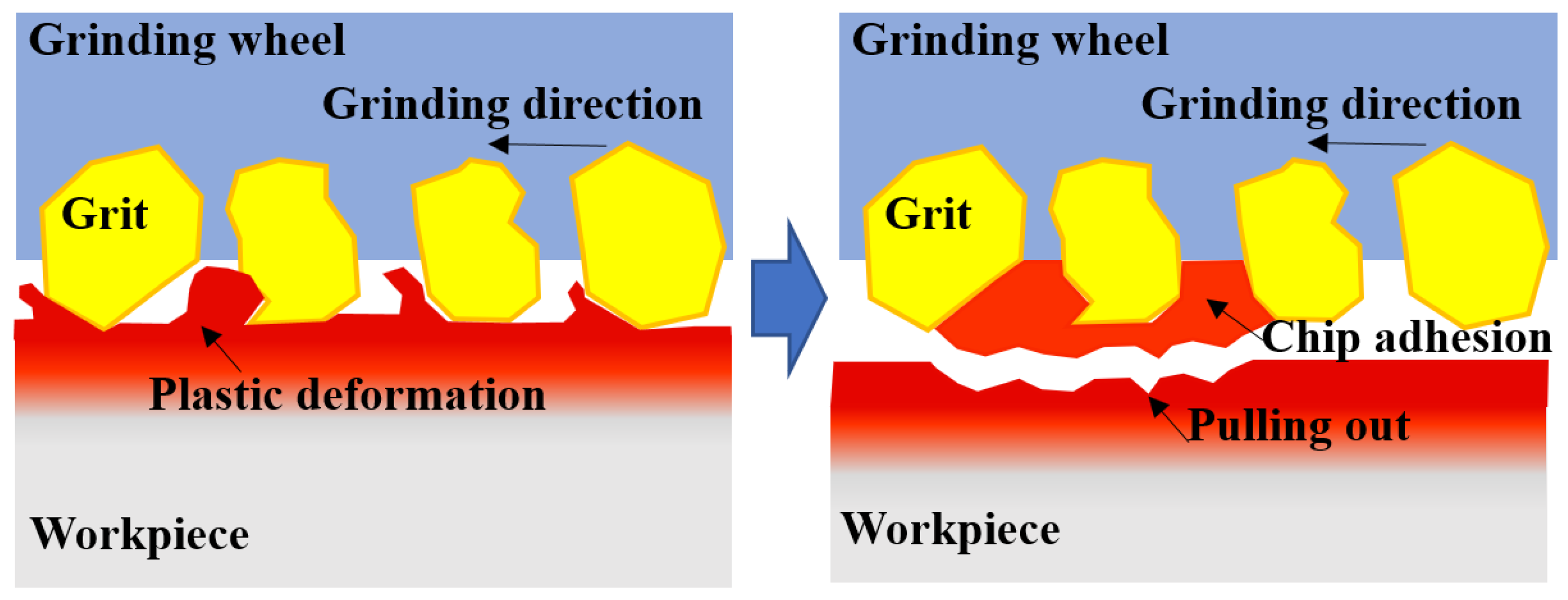
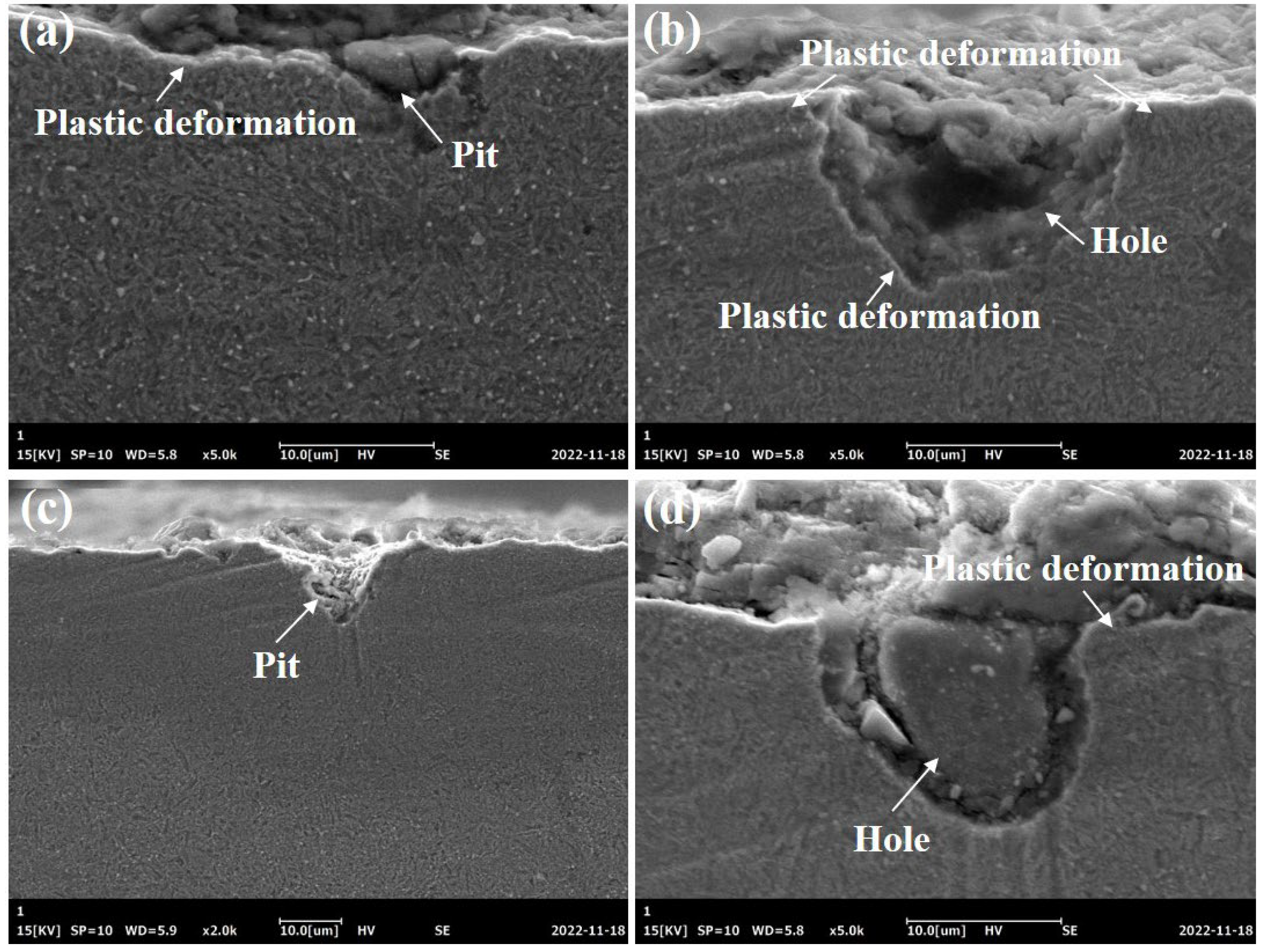

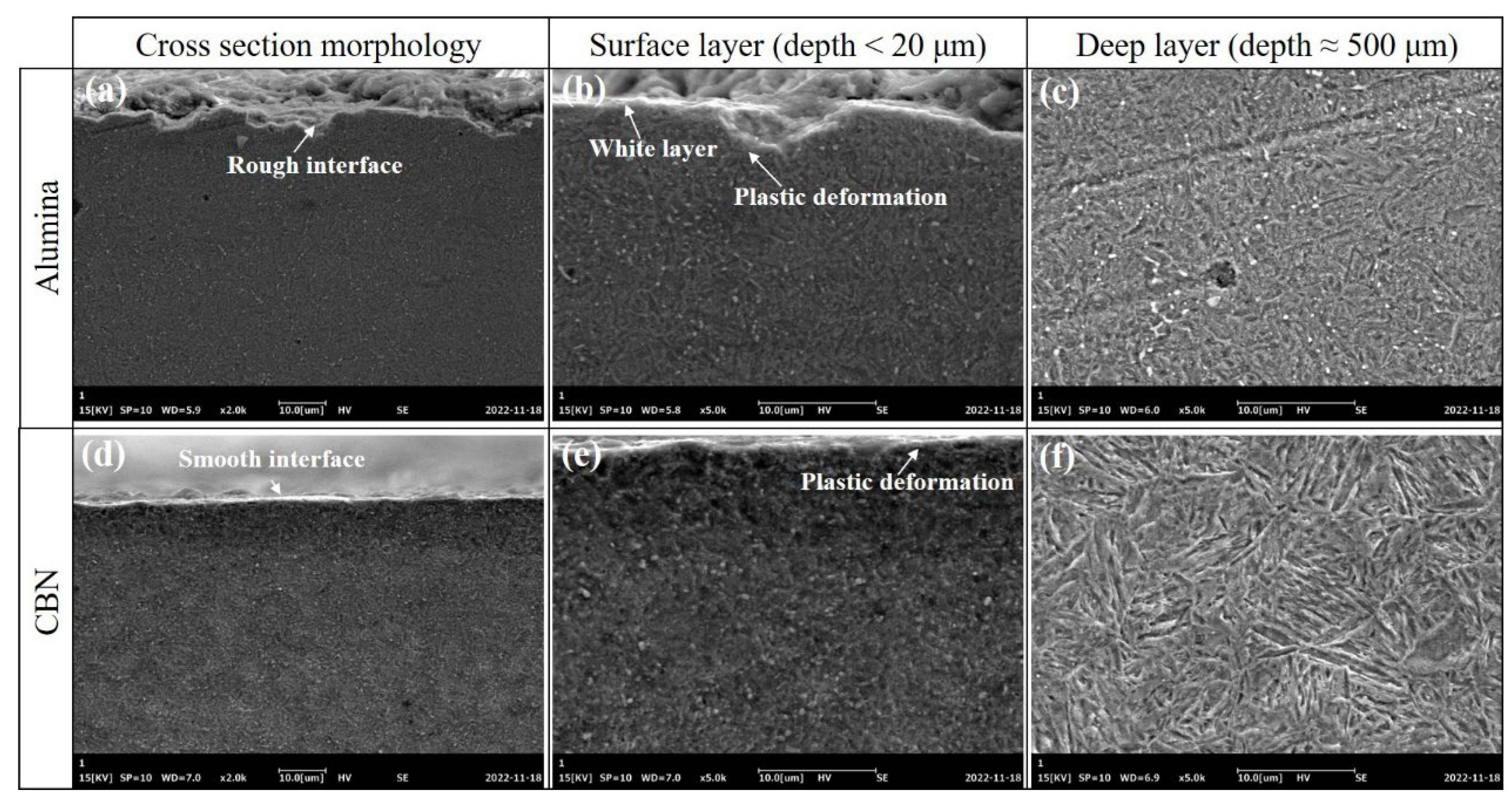

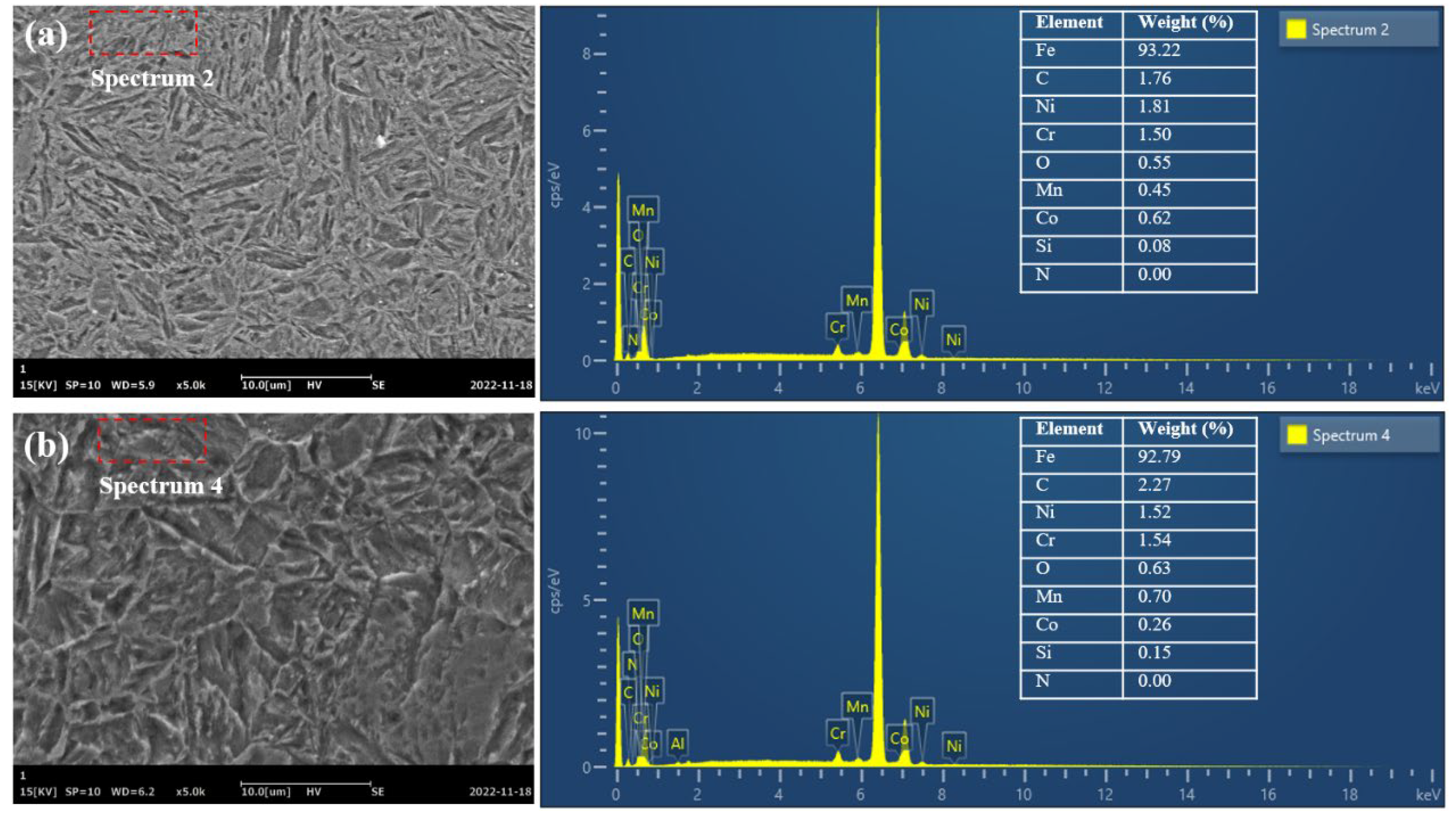
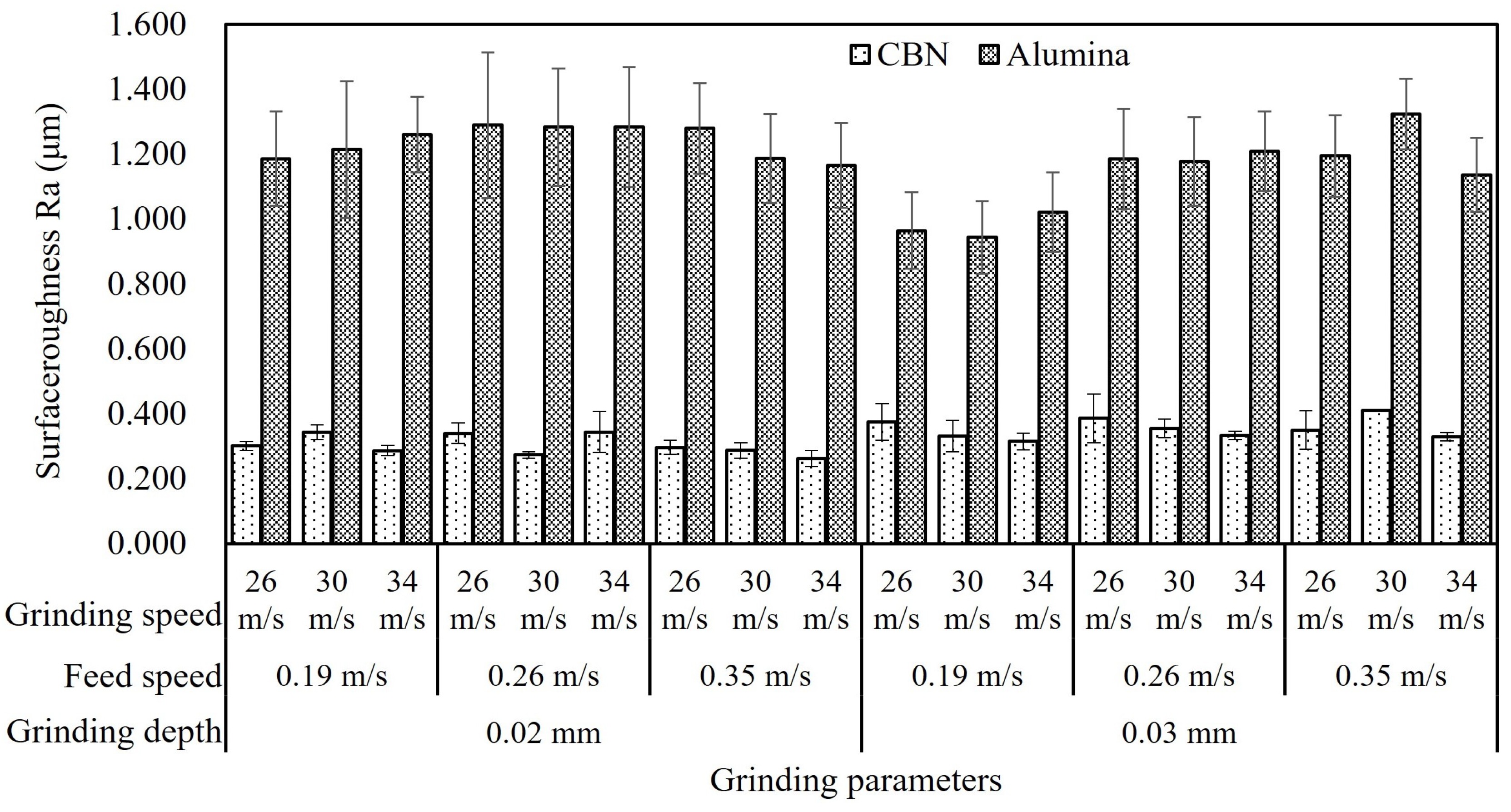
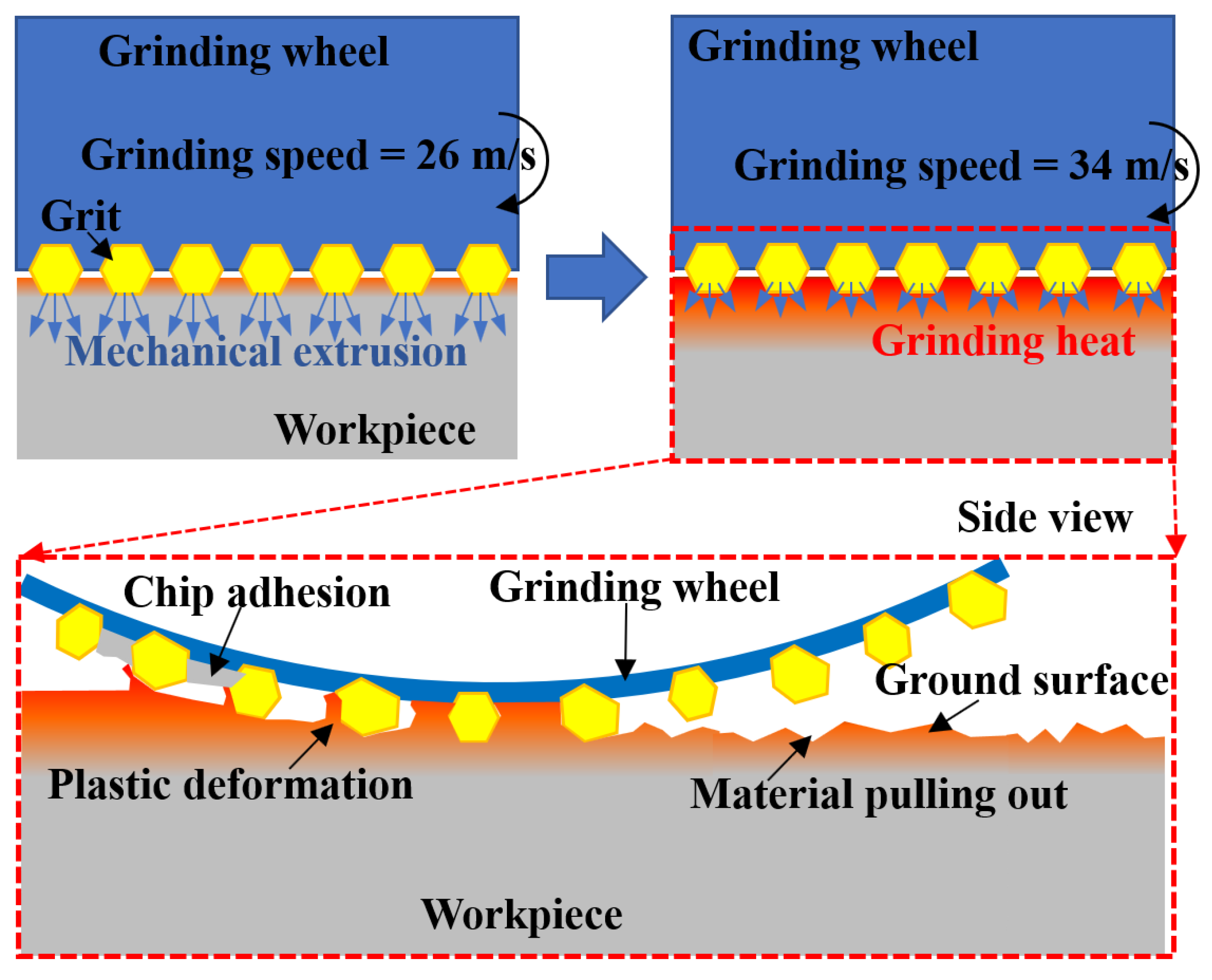
| C | Si | Mn | Cr | Ni | Al | Mo | V | Nb |
|---|---|---|---|---|---|---|---|---|
| 0.188 | 0.015 | 0.40 | 1.83 | 1.63 | 0.048 | 0.31 | 0.093 | 0.059 |
| 2% YS (MPa) | UTS (MPa) | EL (%) |
|---|---|---|
| 964~1362 | 1019~1456 | 12.48~14.80 |
| Grinding Parameters | Level 1 | Level 2 | Level 3 |
|---|---|---|---|
| Grinding depth (mm) | 0.02 | 0.03 | |
| Feed speed (m/s) | 0.19 | 0.26 | 0.35 |
| Grinding speed (m/s) | 26 | 30 | 34 |
Disclaimer/Publisher’s Note: The statements, opinions and data contained in all publications are solely those of the individual author(s) and contributor(s) and not of MDPI and/or the editor(s). MDPI and/or the editor(s) disclaim responsibility for any injury to people or property resulting from any ideas, methods, instructions or products referred to in the content. |
© 2023 by the authors. Licensee MDPI, Basel, Switzerland. This article is an open access article distributed under the terms and conditions of the Creative Commons Attribution (CC BY) license (https://creativecommons.org/licenses/by/4.0/).
Share and Cite
Jiang, X.; Liu, K.; Si, M.; Li, M.; Gong, P. Grinding Force and Surface Formation Mechanisms of 17CrNi2MoVNb Alloy When Grinding with CBN and Alumina Wheels. Materials 2023, 16, 1720. https://doi.org/10.3390/ma16041720
Jiang X, Liu K, Si M, Li M, Gong P. Grinding Force and Surface Formation Mechanisms of 17CrNi2MoVNb Alloy When Grinding with CBN and Alumina Wheels. Materials. 2023; 16(4):1720. https://doi.org/10.3390/ma16041720
Chicago/Turabian StyleJiang, Xiaoyang, Ke Liu, Mingda Si, Maojun Li, and Pan Gong. 2023. "Grinding Force and Surface Formation Mechanisms of 17CrNi2MoVNb Alloy When Grinding with CBN and Alumina Wheels" Materials 16, no. 4: 1720. https://doi.org/10.3390/ma16041720





